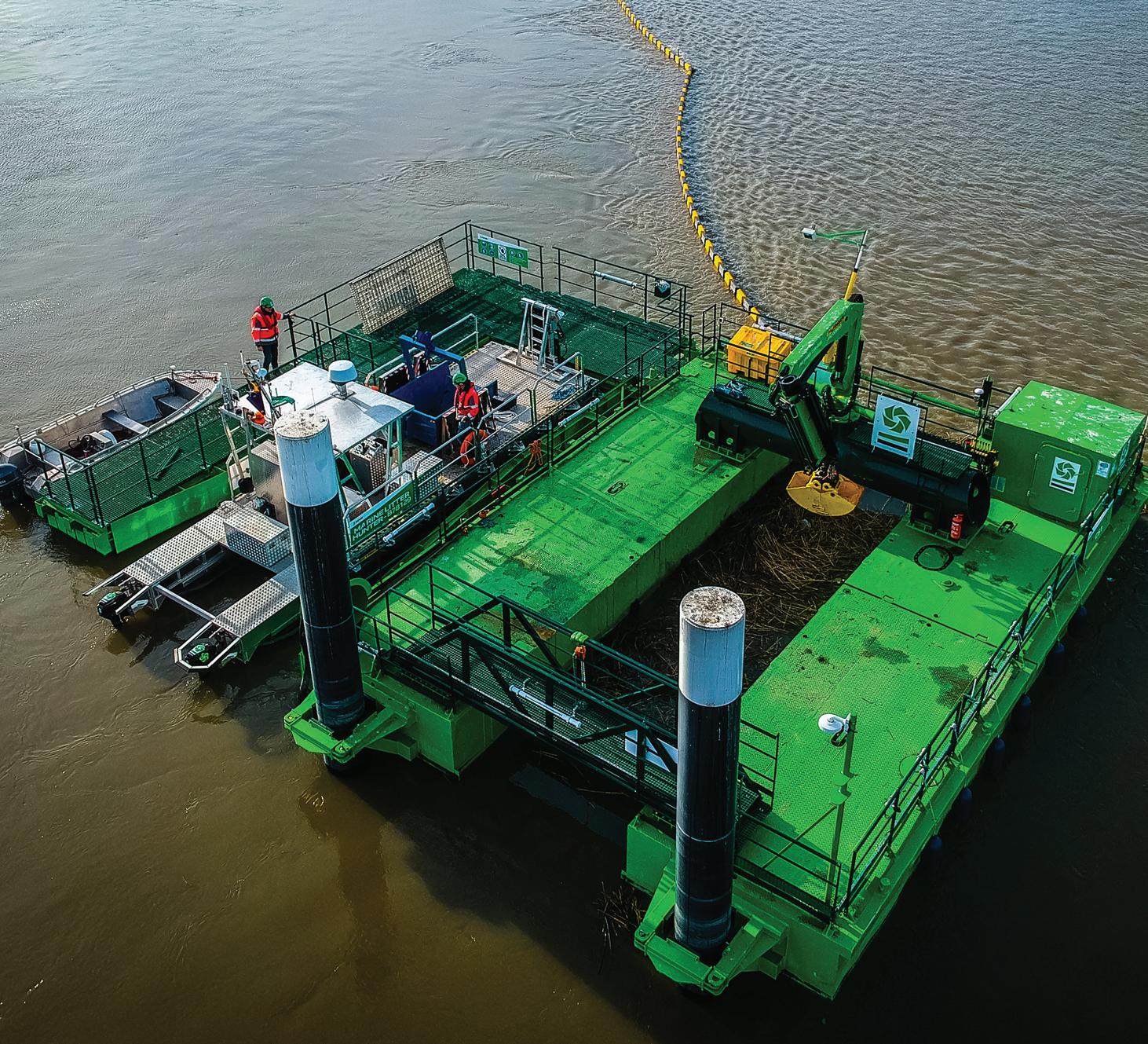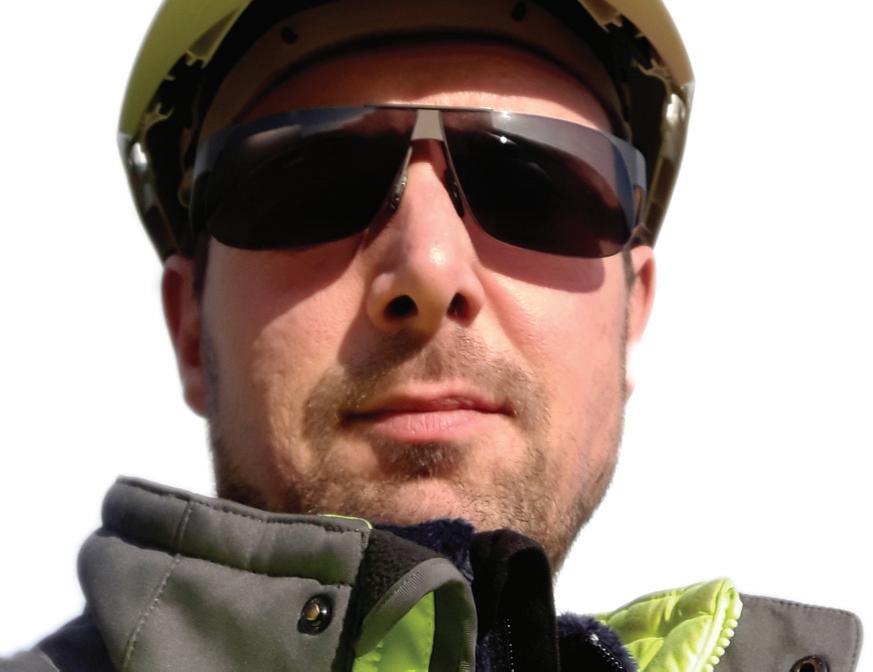
6 minute read
Pollution
DEALING WITH FLOATING DEBRIS
In this Q&A, GreenPort talks with Gregory Duquennois from Bolina Ltd, a company on a mission to clean up floating debris in the waterways
Q Why is the Bolina project so innovative? A In an effort to improve the water quality of Europe's rivers, Bolina Ltd, an Ecocoast company, has engineered the longest floating debris boom to catch plastic and other floating debris.
The boom, installed on the Belgian tidal river of Scheldt, funnels 218kg a day into the plastic catcher, removing seven tonnes of debris and human pollutants a month from the river.
An innovative design was required due to its tricky location on the river Scheldt near the Temse Bridge. Various factors came into play including the tidal effect of up to six metres, the alternating current directions and water speeds of up to two metres per second, as well as the river being a busy shipping route - a fitting challenge for both Bolina and DEME.
The original design integrated the tried and tested Bolina floating debris booms that would rise and fall with the tide. Two giant 'arms' would form a funnel and guide the pollution towards the plastic collector to be trapped and then disposed of by means of a waste container and an autonomous vessel. Both arms are constructed from one full length, without intermediate pieces or other connections in order to maintain maximum tensile strength. The arms span 103 metres for the northern side of the funnel and the southern arm is 175 metres.
Due to the extreme tidal effect, Bolina D-500 pile drivers were provided at the beginning of the booms, which followed the full height difference of six metres, four times a day. At the plastic collector, a special roller system was designed for the connection between the Bolina floating debris booms and the collector itself. The new roller system allows free movement between the dirt screen and the pontoon in the event of strong waves and tides, without losing any plastic or floating debris.
The project utilised autonomous technology such as an installed pontoon, which is automatic and a collecting vessel to transport the debris onshore. Another innovative aspect of the project is the VR-technology, used to monitor and operate the installation remotely, which will identify the difference between a kayaker and a piece of timber that needs to be collected.
How does the boom work?
A DEME installed a litter trap in Temse, with a floating funnel, made with Bolina Debris Booms that cover part of the river. Operational 24/7, it catches and collects drifting debris inside the Bolina floating debris boom. The booms guide the debris and plastic waste towards the litter trap, which collects everything from masks, to pieces of timber that would damage vessels on the river. Once the litter trap is full, everything is transferred into a CO2 neutral DEME vessel using VR technology. The debris is then transported to the riverbank, where DEME transfers once again the litter for collection and processing.
How can the system compliment the work that ports are doing to clean up their waters?
If this DEME project was installed at strategic points, it would not interfere with ships, while creating an automatic
8 An innovative
design was required due to the tricky location on the river Scheldt near the Temse Bridge
system for clean water, trapping the debris and human pollutants at the source and also protecting the vessels.
Q A
Could the installation be set up at a harbour/port entrance or is the aim to stop the litter from reaching the port?
This project would work perfectly if the port is situated at a downstream river.
Q
Where could we see the system being used next?
A This installation at Temse is currently the only one of its kind, and set to be a case study and example to waterway, government and environmental organisations who are looking for innovative products for their regions.
QWhat further product solutions are in the pipeline to assist in cleaning up the rivers/waterways? A Currently, Bolina Environment Booms are used for pollution control in sensitive areas, such as industrial sites, nature reserves, harbours or marinas, pumping stations, water treatment works, dam spillways, just to mention a few. They are the toughest of their type, proudly designed and manufactured in the United


Kingdom. The booms are unique in the market as the only fully flush faced debris booms currently available. The design makes the booms self-clearing when installed at a suitable angle to the current flow, allowing for easy debris collection at a convenient point or deflecting debris away from sluices or intakes to stop them from getting blocked.
Two new products are currently in the pipeline, which will be released by mid-year, suitable for oil and debris containment.
Stopping the spread of plastic
8 Bolina Ltd has
engineered the floating debris boom to catch plastic and other floating debris
8 Gregory
Duquennois, Bolina agent Netherlands and Belgium
Photo: Bolina Ltd
Bolina booms can help stop the spread of plastic in our waterways.
Research shows that river floods are boosting the spread of plastic around the world, raising fears over the potential health risks posed to people and wildlife - even a lowseverity flood can boost the spread potential of plastic nearly ten-fold when compared to nonflooding conditions.
Furthermore, the ability of floods to increase the spread of plastic is greatest in the developing world, where the rates of plastic pollution are the highest and flood defences are inadequate. For example, in Bangladesh the country facing the highest increase in the spread of plastic during floods - a low severity flood can lead to a 40-fold increase in the spread potential of plastic, when compared to non-flooding conditions, the report says.
This is by no means a developing world problem either, with cities in the 'developed world' also contributing hugely to the plastic pollution problem. In fact, one of the study's lead authors points out that if plastics get flushed out of a city and into its sewer networks, the pollution can end up in river systems hundreds of kilometres away, making it much more difficult to clean up.
With the world producing around 350 million tonnes of plastic a year, this is not a problem that is going away anytime soon. Alarmingly, it is not quite clear to researchers where all the plastic waste ends up, with between 10,000 to 100,000 tonnes of what is produced ending up in the world's oceans. It is clear that urgent action needs to be taken, and while not every piece of plastic can be removed from our waterways and systems, there needs to be systems in place to mitigate its spread.
Bolina Booms concentrates exclusively on waterway barriers and floating booms, providing a complete service including surveying, pile design, custom boom designs and support right through to deployment.
The company has a wide range of project experience including the manufacture of safety booms for the Dutch and French waterways and a 500m Litter Fence Boom to protect a nature reserve for Cardiff Harbour Authority in the UK.










